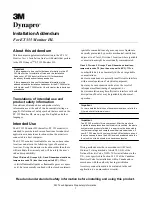
S&C Instruction Sheet 663-500 17
Installation
Fault Indicators
STEP 10.
Optional mounting provisions for fault
indicators (catalog number suffix “-F1” or “-F2”)
are available. Fault indicators are to be
furnished by the user and installed in accordance
with the manufacturer’s instructions. If
mounting provisions are specified, mount the
fault indicators on the mounting brackets and
attach the associated sensors to the cables
below the cable terminators.
Completing the Installation
STEP 11.
Optional surge arresters (catalog number
suffixes “-N6” through “-N10”) and optional
mounting provisions for base-mounted surge
arresters (catalog number suffixes “-P1” through
“-P5”) are available. These options include
mounting provisions, surge arresters (when
specified), and hard-drawn copper connectors
to connect the surge arresters to the terminal
pads of the Mini-Rupter Switch.
Install and connect surge arresters in accor-
dance with the manufacturer’s instructions.
WARNING
Always use the hard-drawn copper
connectors provided to connect the surge
arresters to the Mini-Rupter Switch . Do not
use flexible leads . Use of flexible leads can
result in a flashover, injury, and equipment
damage .
STEP 12.
If any switch interphase or end barriers (where
applicable) were removed to facilitate cable
termination, reinstall them now. Position the
rear of each barrier in the appropriate support
notch of the barrier guide mounted on the base
of the Mini-Rupter Switch. Then, tighten the
wing-head screw of the barrier securely to the
barrier-support angle at the front of the switch
compartment. Make sure the clearance from
the barriers to energized parts and from the
barriers to terminator skirts conforms to the
minimum dimensions specified in Step 5 on
page 13.
WARNING
Verify the rear of each switch barrier is
correctly positioned in its support notch
on the switch frame and the front of
the barrier is securely fastened to the
barrier-support angle . Failure to properly
reinstall the switch barriers will reduce the
clearance between the barriers and
energized parts or terminator skirts,
and can result in a flashover, injury, and
equipment damage .
STEP 13.
Check functional operation of key interlocks, if
furnished.
WARNING
An extra set of keys is provided with
pad-mounted gear that has optional key
interlocks . These keys are for use only
during installation . After installation,
either: (1) destroy the extra set of keys or
(2) make them accessible only to authorized
persons . This will maintain the integrity of
the key-interlock scheme .
Note:
Key interlocks are not security locks
and are not a substitute for padlocks .
NOTICE
Do not force doors open . Forcing a door
can damage the latching mechanism .
If optional key interlocks are furnished,
correctly position the interlocks so the
doors can be opened .
STEP 14.
Make sure the doors open and close without
binding and the shimming of the pad-mounted
gear enclosure is adequate. A resilient closed-
cell gasket on the bottom flange of the enclosure
protects the finish from being scratched during
installation and isolates it from the alkalinity of
the concrete foundation. This gasket also helps
seal the enclosure to the foundation and guard
against entry of rodents, insects, or weeds.



































